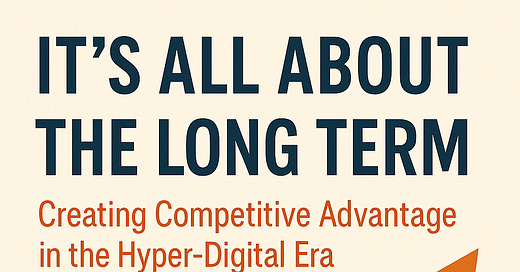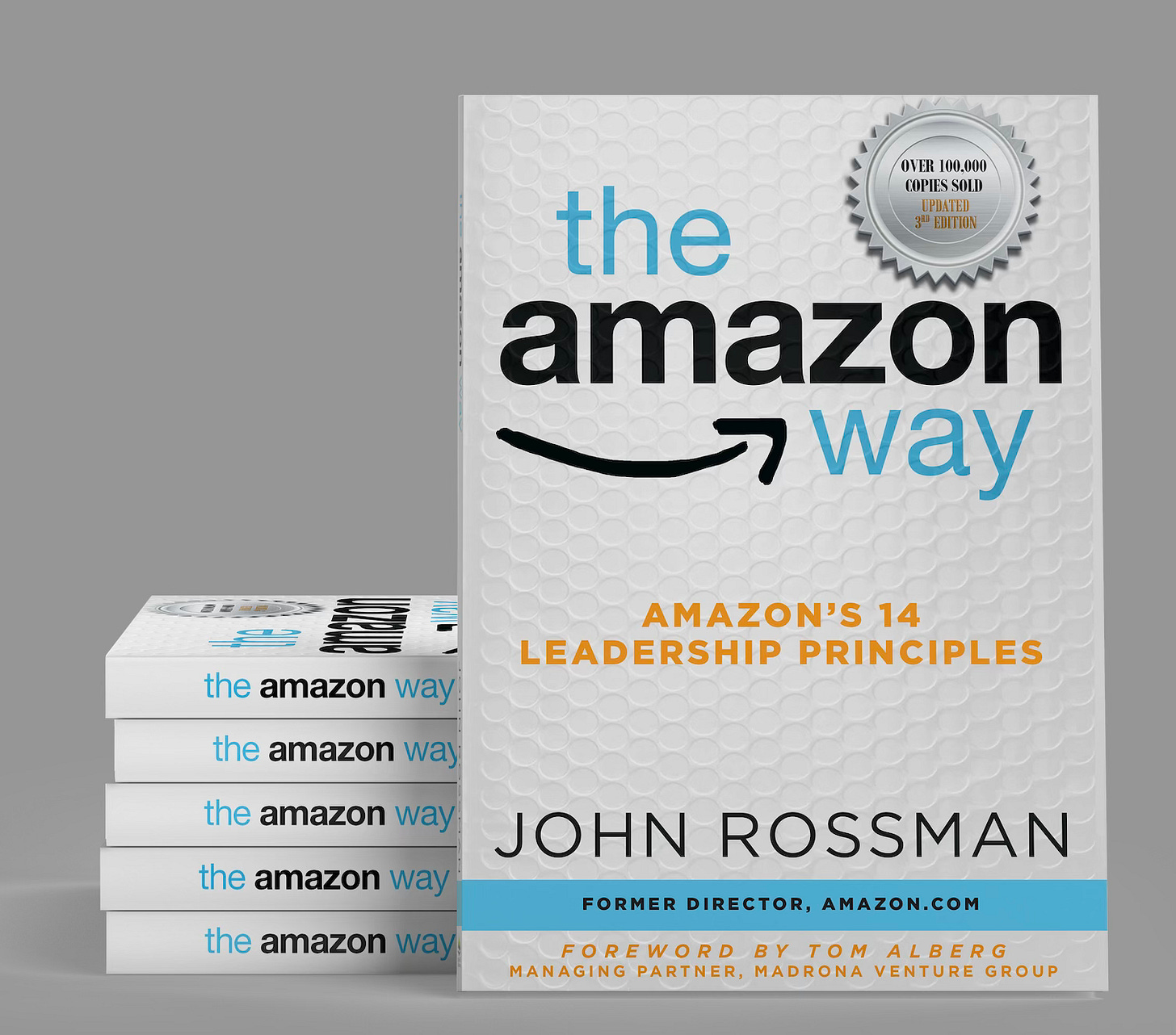“I frequently get the question: ‘What’s going to change in the next 10 years?’
And I almost never get the question: ‘What’s not going to change?’” — Jeff Bezos
In a world addicted to short-term performance—quarterly earnings, trending headlines, and the naive desire for immediate results on hard problems—what truly builds enduring, valuable businesses?
At Amazon, where I had the privilege to be an early executive, the answer was always the same: it’s all about the long term.
This mindset didn’t just shape a company. It’s a lesson every business executive, operator, and investor should embrace now more than ever, especially in an era defined by AI, exponential technology, and unprecedented competitive pressure.
From the Start
Jeff Bezos wrote in the 1997 Amazon Shareholder Letter, titled “It’s All about the Long Term”:
“We believe that a fundamental measure of our success will be the shareholder value we create over the long term.”
This wasn’t an empty-calorie marketing slogan—it is a decision-making lens, a management philosophy. Whether it was building AWS when it had no obvious demand or allowing Kindle to cannibalize the physical book business, Amazon was built by making hard choices that didn’t pay off next quarter but made the company unassailable years later.
In a 2011 interview Bezos elaborated:
“If everything you do needs to work on a three-year time horizon, then you’re competing against a lot of people, But if you’re willing to invest on a seven-year time horizon, you’re now competing against a fraction of those people, because very few companies are willing to do that. Just by lengthening the time horizon, you can engage in endeavours that you could never otherwise pursue. At Amazon we like things to work in five to seven years. We’re willing to plant seeds, let them grow—and we’re very stubborn. We say we’re stubborn on vision and flexible on details.”1
This is the core insight: long term thinking is a competitive advantage—because so few have the discipline or governance to pursue it.
Long Term Thinking Builds Moats
—If Done Right
Let’s be clear—long term thinking is optional. Many companies, probably most companies, get by without it. But the ones that build durable competitive advantages—the ones that become essential to their customers and impossible to displace—think and act for the long term by design.
Long term bets don’t mean deferring value. The best ones pay off in both the short term and the long term. That’s only possible if you focus your investments on durable customer needs and operational capabilities—the areas of your business that matter today and will still matter five years from now.
This approach allows you to:
Build systems and services that compound in value.
Assign true ownership and accountability to critical domains.
Develop a long term lens without sacrificing short term urgency.
Treat innovation not as a side hustle, but as core capability.
When you get this right, you don’t just survive changing markets—you become the platform others depend on and the business riding the momentum of change. That’s the difference between a participant and a category definer.
As we stress in Big Bet Leadership, big bets (when done right) are not gambles. They are calculated, bold commitments that—when aligned with a compelling long term vision—create asymmetric returns.
Big bets are how you reduce risk over the long term.
But Yet, Speed Matters, a Lot
A common misconception about long term thinking is that it excuses poor short term performance—or worse, a lack of urgency. Nothing could be further from the truth.
Andy Jassy, now CEO of Amazon, captured this duality perfectly when reflecting on Jeff Bezos’ leadership:
“He [Bezos] is really thoughtful around being strategically patient, and tactically impatient. He has conviction about long-term vision and where he wants to take something. But, in the interim, even though it may take us a long time to get to where we want to go, he understands that speed disproportionately matters. And really it is true in startups, and it is true in big companies. Speed always matters a lot.”2
This is the paradox leaders must embrace: be patient with vision, but relentless and impatient in execution.
Long-term investments like Prime, AWS, and robotics weren’t a pass for underperformance—they raised the bar. These bets demanded sharper execution, faster cycles, and higher customer expectations. The long term strategy didn’t soften accountability—it made it non-negotiable.
Long term vision without short term discipline is fantasy.
Short term discipline without long term vision is a trap.
The real advantage is balancing both, every single day.
Innovation Loves Constraints
Amazon’s approach to innovation is often misunderstood as quirky. But tools like the press release-first model, single-threaded leadership, and written narratives over slide decks aren’t quirks—they're mechanisms. Purpose-built structures designed to force clarity, ensure focus, and reinforce long-term decision-making.
Jeff Bezos put it plainly in the 2010 Shareholder Letter:
“Good process serves you so you can serve customers. But if you’re not watchful, the process can become the thing.”
That’s the risk: confusing motion for progress; form over function. When process becomes the goal, critical thinking, ownership, and accountability stalls. When principles, mechanisms and wise operators come together, you get the everything — better results, faster progress and an anti-fragile organization.
If you’re a business executive trying to accelerate results, how do you put in place the principles, mechanisms, constraints and forcing functions to get your version of everything?
True competitive advantage requires discomfort from truth-seeking and accountability, insights and risk-based allocation decisions (your strategy and big bets), and long-term commitment. It doesn’t happen on accident. It happens on purpose.
Long Term Thinking Is a Leadership Mandate
Long term thinking isn’t a personality trait—it’s a choice. A discipline. And most of all, a responsibility. As leaders, our job is to build the systems, culture, and conviction that make long-term success not just possible, but inevitable.
That might mean:
Educating your board to value and incorporate long term metrics
Compensating executives on 3–5 year horizons
Reinvesting a higher percentage of profits into big bets and innovation
Choosing the hard, non-conventional path over the convenient one
Crafting bold strategies—and aligning your organization around them.
This is The Amazon Way. Not just principles on paper, but mechanisms in motion—used to scale, innovate, and lead.
The future doesn’t reward just speed and innovation. It rewards resilience, intent, and discipline. It rewards a long term perspective. And that only happens when you commit—decisively—to building something that lasts.
If you’re facing high stakes decisions, growth pressure, or are building your next big bet—I’d love to hear from you.
Let’s talk about your strategy, leadership and company dynamics, and how to design for long term advantage in a short term world.
Connect with me directly—your long term might just start with the next conversation.
Onward,
John
Author of The Amazon Way, Think Like Amazon, and Big Bet Leadership
Advisor | Keynote Speaker | Early Amazon Executive|
Jeff Bezos Owns the Web in More Ways Than You Think". Interview with Steven Levy, www.wired.com. November 13, 2011
https://www.geekwire.com/2017/4-traits-make-amazons-jeff-bezos-unusual-tech-leader-according-aws-ceo-andy-jassy/?utm_source=chatgpt.com






"Long Term Thinking Builds Moats" is the greatest statement here to induce an additional layer of thinking if strategizing to do a Big Bet disruption in a sector.
While I have been thinking of reducing the moat size for clients in a marketplace, I forgot about ensuring a wider moat for either competitors or existing players.
Thanks, John!